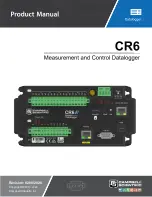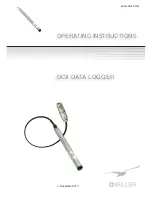
Section 7. Installation
208
FlagsBool8(1) = Flags
AND
&HFF
'AND 1st 8 bits of "Flags" & 11111111
FlagsBool8(2) = (Flags
>>
8)
AND
&HFF
'AND 2nd 8 bits of "Flags" & 11111111
FlagsBool8(3) = (Flags
>>
16)
AND
&HFF
'AND 3rd 8 bits of "Flags" & 11111111
FlagsBool8(4) = (Flags
>>
24)
AND
&HFF
'AND 4th 8 bits of "Flags" & 11111111
CallTable
(Bool8Data)
NextScan
EndProg
7.7.8 Data Output: Using Data Type NSEC
Data of NSEC type reside only in final-data memory. A datum of NSEC consists
of eight bytes — four bytes of seconds since 1990 and four bytes of nanoseconds
into the second. Nsec is declared in the Data Type parameter in final storage
output processing instructions
.
It is used in the following applications:
•
Placing a time stamp in a second position in a record.
•
Accessing a time stamp from a data table and subsequently storing it as
part of a larger data table. Maximum(), Minimum(), and FileTime()
instructions produce a time stamp that may be accessed from the
program after being written to a data table. The time of other events,
such as alarms, can be stored using the RealTime() instruction.
•
Accessing and storing a time stamp from another datalogger in a PakBus
network.
7.7.8.1 NSEC Options
NSEC is used in a CRBasic program one of the following ways. In all cases, the
time variable is only sampled with a Sample() instruction, Reps
=
1.
1. Time variable is declared As Long. Sample() instruction assumes the time
variable holds seconds since 1990 and microseconds into the second is 0.
The value stored in final-data memory is a standard time stamp. See CRBasic
example NSEC — One Element Time Array
(p. 208).
2. Time-variable array dimensioned to (2) and As Long — Sample() instruction
assumes the first time variable array element holds seconds since 1990 and the
second element holds microseconds into the second. See CRBasic example
NSEC — Two Element Time Array
(p. 209).
3. Time-variable array dimensioned to (7) or (9) and As Long or As Float —
Sample() instruction assumes data are stored in the variable array in the
sequence year, month, day of year, hour, minutes, seconds, and milliseconds.
See CRBasic example NSEC — Seven and Nine Element Time Arrays
(p. 210).
CRBasic example NSEC — Convert Time Stamp to Universal Time
(p. 208)
shows
one of several practical uses of the NSEC data type.
Summary of Contents for CR3000 Micrologger
Page 2: ......
Page 3: ......
Page 4: ......
Page 6: ......
Page 30: ......
Page 34: ......
Page 36: ......
Page 96: ......
Page 485: ...Section 8 Operation 485 8 11 2 Data Display FIGURE 110 Keyboard and Display Displaying Data ...
Page 487: ...Section 8 Operation 487 FIGURE 112 CR1000KD Real Time Custom ...
Page 491: ...Section 8 Operation 491 FIGURE 116 Keyboard and Display File Edit ...
Page 496: ......
Page 502: ......
Page 564: ...Section 11 Glossary 564 FIGURE 126 Relationships of Accuracy Precision and Resolution ...
Page 566: ......
Page 594: ......
Page 598: ......
Page 600: ......
Page 602: ......
Page 624: ......
Page 642: ......
Page 643: ......
















































